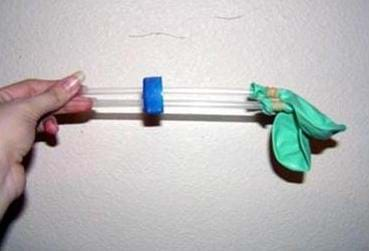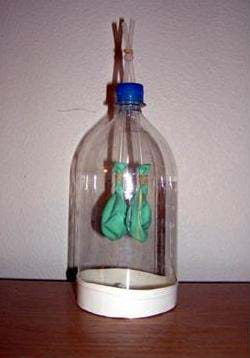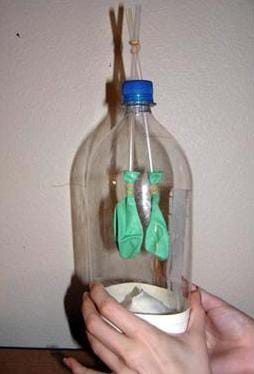FREE K-12 standards-aligned STEM
curriculum for educators everywhere!
Find more at TeachEngineering.org .
- TeachEngineering
- Creating Model Working Lungs: Just Breathe

Hands-on Activity Creating Model Working Lungs: Just Breathe
Grade Level: 5 (3-5)
Time Required: 45 minutes
Expendable Cost/Group: US $2.00
Group Size: 2
Activity Dependency: Lesson 9
Associated Informal Learning Activity: Creating Model Lungs: Just Breathe!
Subject Areas: Biology
Curriculum in this Unit Units serve as guides to a particular content or subject area. Nested under units are lessons (in purple) and hands-on activities (in blue). Note that not all lessons and activities will exist under a unit, and instead may exist as "standalone" curriculum.
- Walk, Run, Jump!
- Muscles, Muscles Everywhere
- Fascinating Friction!
- Design Devices to Help Astronauts Eat: Lunch in Outer Space!
- Blood Cell Basics
- The Beat Goes On
- Do You Have the Strength?
- 20/20 Vision
- Engineering a Mountain Rescue Litter
- Endocrine Excitement!
- Kidney Filtering
TE Newsletter
Engineering connection, learning objectives, materials list, worksheets and attachments, more curriculum like this, introduction/motivation, vocabulary/definitions, troubleshooting tips, activity extensions, activity scaling, user comments & tips.

By studying the respiratory system, engineers have created technologies such as the heart-lung machine, which keeps patients alive during heart transplants. Engineers are currently working on creating an implantable, artificial lung to aid people with serious lung diseases. One way that engineers study complicated systems is by creating models, similar to how students create their own model lungs in this activity.
After this activity, students should be able to:
- Describe the function of the respiratory system.
- Create a model of the lungs and explain what happens to them when you inhale and exhale.
- Give examples of engineering advancements that have helped with respiratory systems.

Educational Standards Each TeachEngineering lesson or activity is correlated to one or more K-12 science, technology, engineering or math (STEM) educational standards. All 100,000+ K-12 STEM standards covered in TeachEngineering are collected, maintained and packaged by the Achievement Standards Network (ASN) , a project of D2L (www.achievementstandards.org). In the ASN, standards are hierarchically structured: first by source; e.g. , by state; within source by type; e.g. , science or mathematics; within type by subtype, then by grade, etc .
Ngss: next generation science standards - science.
View aligned curriculum
Do you agree with this alignment? Thanks for your feedback!
International Technology and Engineering Educators Association - Technology
State standards, colorado - science.
Each group needs:
- 2-liter empty plastic bottle with cap
- 2 plastic drinking straws; available inexpensively at restaurant supply stores or donated by fast-food chains; do not use the flexible drinking straws
- 2 9-inch balloons
- 1 larger balloon; for example, for a punch ball
- 2 rubber bands
- Lung Worksheet , one per student
Have you ever been on a crowded subway or bus? You probably could not wait to get out where there were not so many people and you could move around freely. This is similar to the process that causes air to flow in and out of your lungs. The air molecules are either crowded outside (in the environment) and want to get into the lungs where there are less air molecules (inhalation), or they want to get outside because they are too crowded inside the lungs (exhalation).
When you inhale, your diaphragm muscle contracts downward and rib muscles pull upward causing air to fill the lungs. Can you think of why? Well, when your diaphragm moves down and ribs move up, they make more space in your chest (in the thoracic cavity) for air. This also decreases the pressure on your lungs so the air will flow in from the outside. The opposite happens when you breathe out. Your diaphragm relaxes and the ribs and lungs push in which causes air to be pushed out.
Engineers need to understand the respiratory process in order to design machines and medicines to help people whose respiratory systems function incorrectly or with difficulty. Have you ever known someone who suffers from asthma or pneumonia? Well, chemical engineers design devices and medicines, such as inhalers filled with an adrenergic bronchodilator to help people breathe better. Engineers have also developed artificial lungs that help people breathe while fighting off infections. And engineers also design the systems that help astronauts breathe easily during space flight, when they are far away from the Earth's atmosphere.
Engineers use models to study complicated processes and better understand them. In this activity, you will act like engineers by building models of the lungs in order to study the breathing process and what happens when you breathe in and out.
Before the Activity
- Gather materials and make copies of the Lung Worksheet .
- In each of the 2-liter bottle caps, drill 2 holes that are just big enough for a drinking straw to fit through. Tip: Make sure to drill the holes far enough apart that the holes do not become one big hole!
- Using a pair of scissors, cut off the bottom of each 2-liter bottle.
With the Students
- Peel off the labels, if any, on the 2-liter bottles.
- Tell students that the 2-liter bottle represents the human chest cavity.
- Stick two drinking straws through the two holes in the bottle cap.
- Place one 9-inch balloon on the end of each straw and secure them with rubber bands, as shown in Figure 2.

- Tell students that the straws represent the bronchi and the balloons represent the lungs.
- Stick the balloon ends of the straws through the bottle opening and tightly screw on the lid.
- Stretch out the larger balloon and place it over the open bottom of the bottle.
- Tell students that this larger balloon represents the diaphragm. Now they have a finished model of the lungs! (See Figure 3,) Next, it is time to make the lungs work!

- Pull the diaphragm (balloon) down (that is, away from the lungs) in order to inflate the lungs. (Note: This makes the chest cavity larger and decreases the pressure.)
- Push the diaphragm (balloon) in (towards the lungs) in order to deflate the lungs. (Note: This makes the chest cavity smaller and increases the pressure.)

- Have students complete the worksheet.
- To conclude, have teams make presentations of their model lungs, as described in the Assessment section.
bronchi: Two large tubes connected to the trachea that carry air to and from the lungs.
diaphragm: A shelf of muscle extending across the bottom of the rib cage.
lungs: Spongy, saclike respiratory organs that occupy the chest cavity, along with the heart. They provide oxygen to the blood and remove carbon dioxide from it.
Pre-Activity Assessment
Discussion Questions: Solicit, integrate and summarize student responses.
- How do the lungs work? How do you inhale and exhale?
- Does your breathing change when you exercise? How?
Activity Embedded Assessment
Worksheet: Have students record their observations and complete the Lung Worksheet . Review their answers to gauge their mastery of the subject.
Post-Activity Assessment
Presentation and Informal Discussion: Have one or more groups use their projects to demonstrate how the lungs work. Next, hypothesize with the class: What would happen to the respiratory system if we punctured it? Have one group puncture the cavity (bottle) or diaphragm (rubber bottom) and demonstrate what happens to the lungs if this body part is damaged. (Answer: The lungs are unable to inflate and/or deflate if the chest cavity has a leak. The lungs cannot maintain the pressure difference.) Discuss with the class: What could engineers do to help fix a puncture in a person's lungs?
When cutting off the plastic bottle bottom, make sure that the edges are as smooth as possible so it does not rip the balloon on the bottom. If edges are rough, bind them with masking or duct tape.
Seal any potential leaks with poster tack.
Have students research respiratory diseases and how they affect the function of the respiratory system. Can they alter their model to show what happens to the lungs with these diseases? Can they demonstrate on their models what has been done to help people with respiratory problems?
Engineers have developed an artificial lung to help people fight infection. The artificial lung is approximately 18-inches long and consists of membranes that pass oxygen to the blood and remove carbon dioxide. It is inserted through a vein in the leg and lodged in the main vein (the vena cava) passing blood to the heart. The blood is re-oxygenated through a catheter attached to an oxygen supply. Have students create a drawing of a machine that could help their model lungs "breathe" without having them pull down or push up on the lower balloon. Explain that this is how engineers might begin to develop life-saving machines.
For lower grades, have students make one lung rather than two. Use a smaller water bottle rather than a 2-liter bottle and one balloon lung rather than two.

Students learn about the parts of the human respiratory system and the gas exchange process that occurs in the lungs. They also learn about the changes in the respiratory system that occur during spaceflight, such as decreased lung capacity.

Students are introduced to the respiratory system, the lungs and air. They learn about how the lungs and diaphragm work, how air pollution affects lungs and respiratory functions, some widespread respiratory problems, and how engineers help us stay healthy by designing machines and medicines that su...

To gain a better understanding of the roles and functions of components of the human respiratory system and our need for clean air, students construct model lungs that include a diaphragm and chest cavity. Student teams design and build a prototype face mask pollution filter and use their model lung...

Students are introduced to the concepts of air pollution, air quality, and climate change. The three lesson parts (including the associated activities) focus on the prerequisites for understanding air pollution. First, students use M&M® candies to create pie graphs that express their understanding o...

"How is Asthma Treated?" Diseases and Conditions Index, National Heart, Lung and Blood Institute, National Institutes of Health, U.S. Department of Human Services. Accessed May 23, 2006. http://training.seer.cancer.gov/anatomy/respiratory
"Bronchi and Bronchial Tree." Training Website: Bronchi, Epidemiology and End Results (SEER) Program, U.S. National Cancer Institute's Surveillance. Accessed May 23, 2006. http://training.seer.cancer.gov/anatomy/respiratory/passages/bronchi.html
"Respiratory system." Wikipedia, The Free Encyclopedia, Wikipedia,com. Accessed May 23, 2006. https://en.wikipedia.org/wiki/Respiratory_system
Contributors
Supporting program, acknowledgements.
The contents of this digital library curriculum were developed under grants from the Fund for the Improvement of Postsecondary Education (FIPSE), U.S. Department of Education and National Science Foundation (GK-12 grant no. 0338326). However, these contents do not necessarily represent the policies of the DOE or NSF, and you should not assume endorsement by the federal government.
Last modified: May 1, 2020
